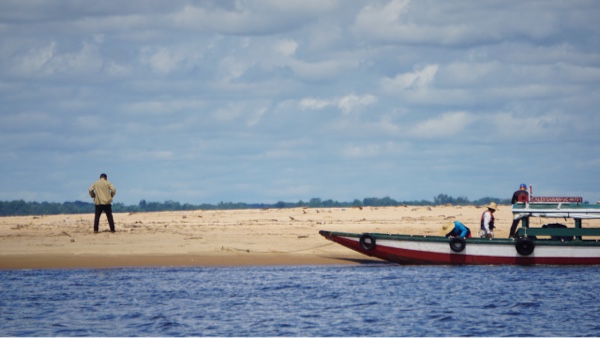Decisions we make now must be robust for the future
Land subsidence damages the foundations of buildings. We can no longer take it for granted that our supplies of good drinking water are adequate. Biodiversity is under pressure. In spatial planning for the Netherlands, not everything is possible any more, everywhere, or all the time. ‘We need to take water and soil into consideration more,’ says director-general Jaap Slootmaker of the Water and Soil Directorate of the Ministry of Infrastructure and Water Management.

Why does the cabinet want to make water and soil leading in spatial planning?
‘We are running up against the limits of what can be achieved by engineering the water and soil system. We have made rivers navigable, reclaimed land, protected the coast from high water and built the Delta Works. The Netherlands can be justifiably proud of what we have achieved and we are very good at it. But there are limits and climate change is stretching the envelope. Over the past five years, we have had serious droughts and floods in Limburg. The frequency and severity of these emergencies is expected to increase. During those years, we have also been considering redesigning our approach to spatial planning. We are facing major challenges: the energy transition, housing, agriculture and nature management. With these transitions, you have to take into account the carrying capacity of our water and soil system, and the changes in that system caused by climate change. This is the time to make water and soil the leading factors in spatial planning for our country.’

Visualisation from the 'On Water basis' report, showing the boundaries of the water and soil system.
What does a policy in which water and soil are leading factors involve?
‘Spatial planning begins with the water and soil system. In the past, we made plans and then looked at how we needed to modify the land and water to achieve our goal. That has been turned on its head: water and soil now lead the process. We live in a delta and that implies limitations: not everything is possible. Last year, Minister Harbers and State Secretary Heijnen informed Parliament about the role of water and soil in future decisions relating to spatial planning. That is reflected in all sorts of measures. Torrential rainfall can submerge entire areas in no time. So more than in the past, you need ways of storing water to mitigate damage. If you want to cope with sea level rise, you need to strengthen coasts, dikes and defences. If you need space to raise and strengthen your dikes, it doesn’t make sense to build in the floodplains of the rivers needed to drain the water. Climate change and land subsidence have been with us for a long time. In the letter sent to Parliament, we now want to give that policy substance by actually adopting water and soil as the leading factors.’

Jaap Slootmaker
Jaap Slootmaker has been the director-general of Water and Soil since 1 July 2020 at the Dutch Ministry of Infrastructure and Water Management. Between 2018 and starting his present job, he was deputy director-general at Rijkswaterstaat. Before that, he worked in a range of management positions at Rijkswaterstaat and the Ministry of Economic Affairs, and he was the Chief Financial Officer at Rijkswaterstaat.
Can you already see this new policy in practice?
‘We’re not starting from scratch. In many places, governments are already taking changing conditions into consideration more, for example in area development or neighbourhood design. I was visiting a new residential area in Almere that they are designing on climate-conscious lines by building parking lots with permeable tiles and playgrounds that act as water storage areas. In several brooks, the original meanders are being restored to retain water longer, and there are good examples where the design of residential areas is based on water and soil. However, a climate-robust Netherlands requires more than the measures that are already in place: we need to allow water and soil to genuinely guide the decisions we make in spatial planning. We are already seeing the philosophy of water and soil as leading factors being reflected in provincial area planning.’

Peat meadow area Kaag and Braassem
What opportunities does this present for other sectors?
‘The letter to Parliament was well received by many sectors but it may be at odds with other ambitions. That’s not particularly surprising because many plans have already been made, and they are sometimes already well advanced. What are the implications for existing plans? If you raise the groundwater level in peatland areas to tackle land subsidence and reduce carbon emissions, that can be at odds with the work of local farmers. The same applies to building in the IJsselmeer, because space is also needed to store water there. The Netherlands is a busy place: everything you do has a downside. Fortunately, we can combine a lot of things. Nature objectives, water and soil quality go well together. And taking a changing future into account in good time prevents much higher costs later. Of course, you can’t everything all at once. If your decision-making is already well advanced, you should still go ahead. We also made that clear in the letter.’

How can knowledge institutes like Deltares contribute?
‘Without their knowledge, we have no idea what climate change will bring. You need to know early what will happen because implementing measures, policy development and public decision-making take time. With scientific studies, Deltares can draw our attention to things that we can’t see yet.

The models and reports based on them, such as the ‘Water-based’ and ‘Water bomb’ reports from Deltares, are crucial for evidence-based policy decisions. They can help us answer policy questions and integrate knowledge, which comes together in policy. It’s sort of yin and yang: we influence each other and complement each other. What does one person see and what does the other need? You can achieve most if you understand that interdependence.’

In which areas does the Ministry of Infrastructure and Water Management want to work with other knowledge institutes in the near future?
‘Together, we need to tackle those big issues such as reducing nitrogen emissions, sustainable housing, land subsidence or declining biodiversity. You see more and more extremes in the climate. Does that still match our computer models? We need to acquire experience together and learn from practice. We don’t know the exact extent of sea level rise. By studying that, we can learn and take steps. Our international role is also important. The fact that Bart van der Hurk of Deltares has joined an IPCC working group is a good thing. In this way, as the Netherlands, we maintain a position among the leaders in the world in this knowledge domain.’
When will you be satisfied with the outcomes of this new policy?
‘Water and soil as leading factors must be anchored in our policies and be at the heart of our approach to spatial planning. It has become a way of thinking. Decisions we make now must be robust for the future. You mustn’t end up in a position where, fifty years down the line, you have to move the houses being built now. I will be satisfied – but I won’t be able to check this myself – if the generation after us concludes fifty years from now that: they made wise decisions and started in time.’

